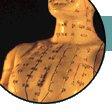Differentiating Syndromes of the Spleen
Spleen failure to carry out transportation and transformation syndromes
Anorexia, abdominal distension after meals, lassitude, sallow complexion, feeble breathing, loose stool, pale tongue proper with white thing coating, retarded and weak pulse.
Spleen xu causes a failure of transportation and transformation, and insufficiency of qi and blood, so the above symptoms appear.
Sinking of spleen qi syndromes
Prolapse of the uterus, gastroptosis, nephroptosis, chronic diarrhea, feeble breathing, yellowish complexion, pale tongue proper with white coating, and xu type pulse.
Spleen qi should ascend, however, spleen xu causes the qi to sink. If the spleen qi is too weak to elevate the zang-fu organs, then the prolapse of internal organs and symptoms showing spleen qi insufficiency occur.
Spleen blood control failure syndromes
Excessive menstruation, uterine bleeding, hemotochezia, bloody urine, purpura, pale complexion, lassitude, pale tongue proper, and a thready weak pulse.
The spleen control blood. If it is unable to carry out this function, then the extravasation of blood occurs, plus the bleeding symptoms mentioned above. Bleeding affects the function of transportation of qi and blood, resulting in a pale complexion, lassitude, a pale tongue proper, and a thready weak pulse, which are signs of qi and blood xu (deficiency).
Pathogenic damp invasion of the spleen syndromes
Distension and fullness of the epigastrium and abdomen, anorexia, stickiness in the mouth, heaviness of the head, absence of thirst, swelling of the face, eyes, and four extremities, loose stool, dysuria, excessive and this leukorrhea, white and sticky tongue coating, and soft thready pulse.
The spleen is adverse to dampness, therefore excessive dampness is liable to affect spleen yang leading to a dysfunction of transportation and transformation, resulting in the symptoms of distension and fullness of the epigastrium and abdomen, and anorexia. Pathogenic damp, which is sticky and stagnant in nature, easily blocks the flow of yang qi, causing a sensation of heaviness of the head. If dampness and fluid pour into the skin and muscles, swelling of the face, eyes, and extremities occurs. If the spleen fails to remove the damp, the stool becomes loose and the urine abnormal. A white and sticky tongue coating and a soft thready pulse are signs of excessive pathogenic damp.
Spleen yang xu syndromes
Dull pain of the epigastrium and abdomen ameliorated by warmth, chills with cold extremities, poor appetite, loose stool, pale tongue proper with white coating, and deep, slow pulse.
Spleen yang deficiency causes the stagnation of cold in the middle jiao, obstructing the functions of qi. Warmth can remove the obstruction, so the pain of the epigastrium and abdomen is ameliorated. Deficiency of spleen yang leads to a dysfunction of transportation and transformation, thus the failure of spleen yang to warm the body surface and extremities, and the occurrence of anorenxia, and loose stool. A pale tongue proper with a white coating and a deep slow pulse are signs of xu cold.
Spleen and stomach damp heat syndromes
Yellow-orange complexion, distension and fullness of the epigastrium and abdomen, nausea, vomiting, poor appetite, aversion to greasy food, heaviness of the body, yellowish urine, loose stool profuse and yellowish leukorrhea, yellowish and sticky tongue coating, soft and rapid pulse.
Damp heat accumulates in the skin causing a yellow-orange complexion. It also blocks the middle jiao causing symptoms of distension and fullness of the epigastrium and abdomen, nausea, vomiting, anorexia, and version to greasy food. Excessive damp causes heaviness and tiredness of the body. Damp heat descending leads to profuse yellowish leukorrhea. Deep yellow urine, loose stool, yellowish and sticky tongue coating, and soft pulse are signs of excessive damp heat.
Related Subjects
Read more on description of the main syndromes of other zang-fu organs:
Heart,
Liver,
Lung,
Kidney,
Small Intestine,
Large Intestine,
Urinary Bladder,
Stomach, and
Gall Bladder.
|

 This website is published, edited and designed by Raymond Cheng,
and reflects only and only his personal views and opinions in his individual capacity.
The information available at this website is not intended
directly or by implication to either diagnose or treat any
medical, emotional, or psychological condition or disorder.
It is also not intended to create a physician-patient relationship
between you and I or between you and Wyith Institute™ and The Office of Dr Raymond K K Cheng.
The information here is not a substitute for advice and treatment provided
by your physician or by another healthcare professional.
It is always recommended that consultation with local healthcare providers
be obtained for any of your specific health or medical concerns.
Furthermore, any products that can be purchased (yet you can see I don't have much
to sell here) through advertisers' banners or through links to other websites
are not either explicitly or implicitly given any warranty or endorsement
by me, my colleagues, Wyith Institute™ or any of its associated businesses.
This website is published, edited and designed by Raymond Cheng,
and reflects only and only his personal views and opinions in his individual capacity.
The information available at this website is not intended
directly or by implication to either diagnose or treat any
medical, emotional, or psychological condition or disorder.
It is also not intended to create a physician-patient relationship
between you and I or between you and Wyith Institute™ and The Office of Dr Raymond K K Cheng.
The information here is not a substitute for advice and treatment provided
by your physician or by another healthcare professional.
It is always recommended that consultation with local healthcare providers
be obtained for any of your specific health or medical concerns.
Furthermore, any products that can be purchased (yet you can see I don't have much
to sell here) through advertisers' banners or through links to other websites
are not either explicitly or implicitly given any warranty or endorsement
by me, my colleagues, Wyith Institute™ or any of its associated businesses.



 Thank you for visiting this TCM and acupuncture information website.
If you have previously been to this website, you might have
noticed that some of the pages on ancient historical ideas and
holistic thinkings related to Chinese metaphysics are temporarily taken offline.
This is because I will be revamping the whole website and be moving
those information into a new \"Ancient Chinese Culture\" section
so as to reflect a more current perspective on the interpretation
of some of the fundamental concepts as well as to include
some of the latest information in the area.
But if you have just found this website for the very first time, I welcome you again and
wish you could find what you require and, hopefully, you could also be benefitted
from reading the articles I published on this website.
Thank you for visiting this TCM and acupuncture information website.
If you have previously been to this website, you might have
noticed that some of the pages on ancient historical ideas and
holistic thinkings related to Chinese metaphysics are temporarily taken offline.
This is because I will be revamping the whole website and be moving
those information into a new \"Ancient Chinese Culture\" section
so as to reflect a more current perspective on the interpretation
of some of the fundamental concepts as well as to include
some of the latest information in the area.
But if you have just found this website for the very first time, I welcome you again and
wish you could find what you require and, hopefully, you could also be benefitted
from reading the articles I published on this website.